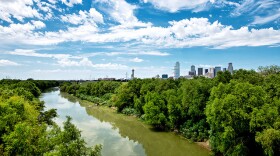The Trinity River in Dallas surged 12 feet above flood level Friday. It’s expected to crest at 43 feet Friday night. And that’s brought a surge of spectators to the Continental Bridge.
Ask people what the Trinity River looked like a couple of months ago, and the answers are pretty snarky.
“Before the water it was just grass and weeds,” says John Jackson.
“A dry gulley,” jokes Linda Lubinsky.
“Three or four months ago, it was, as Vonciel Hill put it, a drainage ditch,” says Andy VanNoord.
But now?
“Just to see that mass of water right in the middle of Dallas is just absolutely amazing. I can’t speak for everybody else, but I think it’s just phenomenal,” Johnson says.
At almost 42 feet, it’s certainly one of the Trinity’s top floods.
But a little over a century ago, the river surged even higher.
“People I think know about the flood of 1908 in which the river crested at over 52 feet, which is pretty impressive,” UT-Arlington history professor Bob Fairbanks says.
Fifteen inches of rain in a single day led to that flood, which caused tens of millions of dollars in damage and left 4,000 people homeless.
The flooding and its aftermath is what “resulted in an interest in doing something to tame the Trinity,” Fairbanks says.
He means the levees. Talk started after the flood of 1908, temporary barriers were built by the end of the '20s, and the levees more or less as we know them today were in place just after World War II.
Fairbanks says it would have been impossible for Dallas to progress without levees. But if for some reason we didn’t have them?
“Downtown would have been basically destroyed by this,” Fairbanks says. “I don’t think it’s quite as bad as New Orleans, but it would have been a very traumatic event in the history of the city.”
Still, there’s no denying the drama of the Trinity today. Fairbanks came to North Texas in 1981, and says he’s not surprised so many people are taking a moment to snap a picture or two.
“I was in Cincinnati before I came down here and I’d been in St. Louis for awhile and I knew what rivers looked like,” Fairbanks says. "And I came down in August and couldn’t even see the Trinity River when I got down here. But now we can see it!”
And on the Continental Bridge, Andy VanNoord is psyched.
“It’s pretty amazing to see the mighty Trinity actually be mighty,” he laughs.
Though, thankfully, not quite as mighty as it was in 1908.








